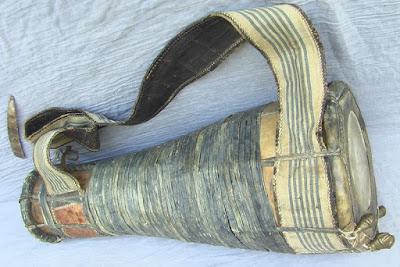Tortoise and the King's Drum
The King's magic drum produced unlimited food and drink. The King alone knew the drum's secret: if the drum's owner stepped over a stick, warriors would come out of the drum and attack him.
Tortoise, who was poor and lazy, wanted that drum. He climbed a palm-tree and waited. When the King walked by, Tortoise dropped a palm-nut.
The King picked it up.
"You stole my food!" Tortoise shouted. "I'm poor; you must pay!"
"Take whatever you want," said the King kindly.
"Give me the drum!" said Tortoise.
Smiling, the King agreed, but he didn't tell Tortoise the drum's secret.
Tortoise is Rich
Tortoise rejoiced. "With this drum, I will have food and drink without working!"
Tortoise ate, and he was happy.
Tortoise fed his family, and they were happy.
Tortoise feasted the whole village, boasting about his wealth. Now everyone admired Tortoise.
One day Tortoise got drunk on palm-wine and started to dance. As he danced, he stepped over a stick.
He wanted more wine, but when he beat the drum, the warriors emerged, armed with whips and clubs, and they attacked Tortoise.
Tortoise was angry. "I should not be the only one to suffer!" he thought, and he made a plan.
Tortoise's Revenge
"When I was poor, everyone mocked me," Tortoise thought. "Now they only pretend to like me, but I'll teach them a lesson."
Tortoise announced another feast. He invited all the men and animals, but he sent his own wife and children away.
Then, when everyone arrived, Tortoise beat the drum. The warriors appeared and attacked all the guests. Tortoise kept drumming, and the warriors kept attacking.
Tortoise didn't stop until all the guests were lying on the ground, groaning in agony.
Then Tortoise went to the King. "This drum is no good!" he said. "You must give me something else."
Tortoise and the Breadfruit-Tree
The King showed Tortoise a magic breadfruit-tree. "Every morning, the tree produces breadfruit. Harvest only once each day, not twice."
Tortoise gathered breadfruit each morning, and his family ate happily.
Tortoise's son asked where the food came from, but Tortoise wouldn't say. So the son poked a hole in Tortoise's sack and filled it with ashes. After Tortoise returned with breadfruit, the greedy son followed the trail of ashes. But when he reached for a breadfruit, a thorn-bush sprang up and swallowed the tree.
When Tortoise came the next morning, there was no tree.
Just a thorn-bush.
No more magic.
Author's notes.
Here is a link to the story: The King's Magic Drum.
The motif of a magical object that can bestow food or punishment regularly shows up trickster stories, including African American trickster stories, like this Anansi tale: Anansi and the Avocado Tree.
The story starts by explaining how the king uses this magic drum to keep the peace: whenever his enemies showed up, the king would use the drum to summon a huge feast, and instead of fighting, he would feed his enemy, and they would leave happy. The king is a very sympathetic character in this story (not always the case with kings in folktales!).
In the original story, it was the princess who picked the palm-nut up and then Tortoise petitioned the king, but to keep the story short, I went straight to the king.
Also, in the original story, the tree drops cooked foo-foo; you can read about foo-foo (fufu) at Wikipedia. I made it a breadfruit tree, since foo-foo is not a familiar term in American English. Breadfruit is not familiar, but at least you can tell right away that it is some kind of foodstuff; more about African breadfruit.
The thorn-bush at the end is called "prickly tie-tie palm" and that is where tortoises supposedly live today.
Image information.
Image information.
Drum: ìyáàlù bàtá drum.
Warriors: Leopard society of Nigerian Egbo warriors.
Breadfruit: Treculia africana.
Breadfruit: also called ukwa.
Tortoise: called ijapa in Yoruba language.





Hi Laura! Before I begin to react to the story.. It is so cool that you're a student too. It adds a different perspective!
ReplyDeleteI really liked how many pictures you included. I haven't thought of adding more than one to be honest, but it gave a lot of extra detail and imagery to the story. It's true, a picture tells a thousand words. Also, separating the story into blocks with a title that describes what is going to happen made the storyline and plot completely clear to the reader, which is helpful when we are comparing it to an original. It also provided foreshadowing. Do you know why magical objects are so common in African American trickster stories? I know a moral lesson is very common across cultures to stories, but it's interesting that objects, specifically magical or entranced ones, are a motif. Also, has there ever been a story from the tortoise's point of view to put him in a better light? There are always two sides to a story, even if one character is the trickster. It would be interesting to see if any of his actions, decisions or resentment seemed justified.
Sincerely,
Rachel
Laura,
ReplyDeleteI really enjoyed reading the story! I liked how you formatted it into different stories or sections almost. I felt like it just gave the story an extra element that I enjoyed. I also loved how you had multiple images. The images really help with the telling of the stories, so I love how I could look at them to better envision the stories. I can't wait to read more of your stories!